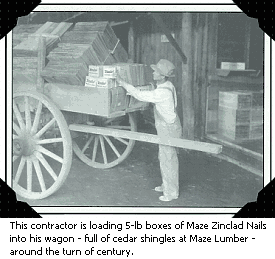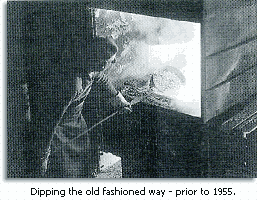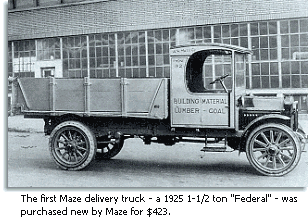Dealers in Lumber & Coal
When Samuel Nesbitt Maze entered the lumber business in 1848, he began an enterprise that would grow and flourish for a century and a half... and beyond. Today, after more than 173 years of successful operations and 6 generations of Maze family members (and with the critical help of our other top-notch associates!), Maze Lumber is still providing construction materials to help build America and the world.

An Irish immigrant from Castleblaney, County Monahgan, Maze arrived in the United States in 1836 and was a masonry contractor for several years before deciding to try his hand at the lumber business. He located his modest yard in the small town of Peru, Illinois - on the banks of the Illinois River. The yard stood just a few hundred yards from the south end of the new Illinois-Michigan Canal. Dug by men and horse power, it was also 1848 when the canal first linked Peru and the Illinois and Mississippi rivers to Lake Michigan.
Maze had a small barge built - named the Elk - and used mules to haul loads of local grain to Chicago by way of the I-M canal. Before leaving Chicago to return to Peru, the Elk was loaded with white pine from the huge timber stands in Wisconsin - for sale to Samuel Maze's contractor friends, and later to everyone, when farmers and others asked him to bring them lumber. Thus the yard was born.
For years, the Maze lumberyard helped to build the growing town of Peru and the many surrounding communities. Today, after 17 decades years of providing only better quality building materials to industry, contractors and homeowners, Maze Lumber continues its long tradition of outstanding customer service to the Illinois Valley. Still located at its original Water Street location, the modern Maze yard handles the latest in construction materials - with prompt delivery and expert advice to accompany each sale.
In the late 1800's, the Maze Lumber yard was selling a great many cedar shingle roof jobs. The shingles lasted fine - but the bright steel cut nails that Maze Lumber sold, though they were the best available at the time, just didn't last very long. The result was blow-offs of the wood shingles due to nail failures. The lumberyard, at that time being run by Samuel Maze's son, Walter, bought a used nail machine so they could make their own, higher-quality nails from pure zinc strips.
It was fortunate that LaSalle-Peru was also home to M & H Zinc and Illinois Zinc - suppliers of the zinc needed to make the cut cedar shingle nails that the small nail machine produced. Pure zinc nails, while they didn't drive extremely well because they were rather soft, accomplished the Maze goal of providing a long-lasting, "rust-proof" nail to their customers - especially in short lengths.

Maze Lumber promoted its cedar shingle roof packages far and wide. They even gave away the zinc cut nails free - if the rest of the job was purchased at their yard. So the little nail machine now had to run more hours a week to keep up with the growing demand.
It didn't take long for word of these fine zinc nails to spread to lumberyards outside the area - and soon other area dealers arrived by wagon, flatboat and sidewheeler to find out more about these popular nails. As Maze Lumber began selling nails to other lumberyards, the nail machine eventually ran full time - then was joined by additional machines as nail orders poured in. So was born the Nail Division of W.H. Maze Company.
In the early 1900's, when the cost of the base metals such as zinc began to skyrocket, the fledgling nail mill devised a way to conserve zinc by making steel nails - then dipping them into a vat of molten zinc. These ZINCLAD® nails drove much better than the old pure zinc cut nails - but still had the excellent rust-resistance to which Maze customers had become accustomed.
For years, ZINCLAD® nails were dipped manually - using a small basket to lower the nails into the molten zinc.
As nail sales climbed to the point where this manual nail dipping method just didn't keep up, the Maze engineers went to work on a new design. The first automated nail dipping line was completed in 1955 - and Double-Dipped STORMGUARD® nails were born. The concept was sound…double-dipping the nails put on considerably more zinc than a single dip. This new method precluded pinholes, globs of zinc and other imperfections - further guaranteeing homeowners that Maze hot-dipped nails would give them decades of rust-free service on their roofing, siding and decking jobs.

Maze Nails was selling many millions of pounds of STORMGUARD® nails annually by the 1960's. Word of their success and dependability spread through the building materials industry - and dozens of manufacturers began recommending them by name. Many actually included Maze STORMGUARD® Nails with their products before they honored their warranty. After all, the best materials will only perform as effectively as the fasteners used to apply them.
Maze Nail engineers were responsible for many other major innovations in the nail business. As building materials changed and improved, it was imperative to develop new methods of fastening them. Maze developed spiral shank threading in 1932 to increase the holding power of their nails. This helped to reduce the problems caused by nails backing out of roofing and siding products.
Maze Nails was also the first mill to pack nails into both 50-lb. and 5-lb. boxes - quite a departure from the old 100-lb. kegs which were considered the standard packing.
Maze Nails has always been on the leading edge of developing nails to apply ever-changing and modern building materials. When hardboard siding first entered the market, for example, shipments of the product were made to lumberyards all over the country. Unfortunately, contractors found that regular box nails and siding nails didn't drive well through the new, tough materials. Maze Nails was quickly contacted - and within several weeks had developed high-carbon steel, small-headed STORMGUARD® siding nails. Those nails soon became the industry standard for hardboard siding nails.
Maze Nails also had the first pressure treated lumber (P.T.L.®) nails to hit the market after the strong emergence of treated lumber. Maze Nails is now providing both bulk and collated hot-dipped (STORMGUARD®) nails for the huge fiber-cement siding market. Such responses to ever-changing trends in building materials have made Maze Nails a leader in the development of nails for a wide range of products. Of course, during wartime, Maze was always a dependable supplier of special nails to the military.
Independent Nail Purchased by Maze in 1990

Independent Nail, founded in 1915 in Bridgewater, MA by the Stone family, was once the nation's largest supplier of specialty nails. Truckloads of paneling nails, drywall nails, and other bright, threaded and painted nails poured from the well-run plant and were distributed by wholesalers nationwide.
Fine merchandising and sales aids gave Independent's STRONGHOLD® nail line brand-name recognition that other nail makers were unable to match for many years. Independent Nail designed many new nails, including ring shank nails for better holding power in 1934. Independent Nail and Maze Nails are widely known as the two producers most instrumental in creating the strong market for specialty nails.
The Independent Nail company purchase gave Maze Company many items that customers were also demanding. These included stainless steel nails, copper nails, plastic head cap nails, metal head cap nails, paneling nails, hardwood trim nails and aluminum nails. The Independent Nail operation ultimately was consolidated into the Illinois operation – so that we could more efficiently manufacture all items here in the Peru Illinois plant.
Strong demand from quality-conscious builders, remodelers and homeowners continue to drive Maze Nail sales into the 21st century – and we appreciate that outstanding loyalty!
Timeline
1836: Samuel N. Maze leaves Ireland for America.
1848: Maze Lumber Founded by Samuel Maze - along IL river in Peru, IL.
1886: Maze Lumber buys first cut nail machine - makes nails from pure zinc.
1896: Maze Lumber designs the area's first drive-through lumber shed.
1900: Maze Nail is the first nail maker to pack fasteners into 50-lb. boxes.
1905: Maze Nail is the first nail maker to pack product into 5-lb. boxes.
1914: Maze Nail produces their first hot-dipped nails - by hand.
1922: Maze Nail Division moves from IL river to their Church Street factory.
1930: Maze Nail designs and introduces spiral shank nails.
1934: Independent Nail designs and introduces ring shank nails.
1955: Maze develops exclusive STORMGUARD Double Hot-Dip Galvanizing line.
1972: "#2" Hot-Dip Galvanizing line completed and running!
1982: New Maze Lumber showroom built - old office demolished.
1988: "#3" Hot-Dip Galvanizing line completed and running!
1990: Independent Nail (Founded 1917) Purchased by Maze Company.
1991: Maze Nails enters the collated nail business.
1996: S.S.E. (Collating Division) Founded at Zibert building.
1998: W. H. Maze Company celebrates 150th Anniversary.
1999: S.S.E. moved to larger Plank Road facility.
2006: "#4" Hot-Dip Galvanizing line completed and running!
2006: Maze Nail earns Miami-Dade County Approval on selected roofing nails.
2011: "#5" Hot-Dip Galvanizing line completed and running!
2011: Diane Sawyer's ABC "Made in America" program highlights Maze Nails
2012: Maze consolidated the Independent Nail plant and their items back to Peru, IL.
2024: Maze is America's premier specialty nail maker.
